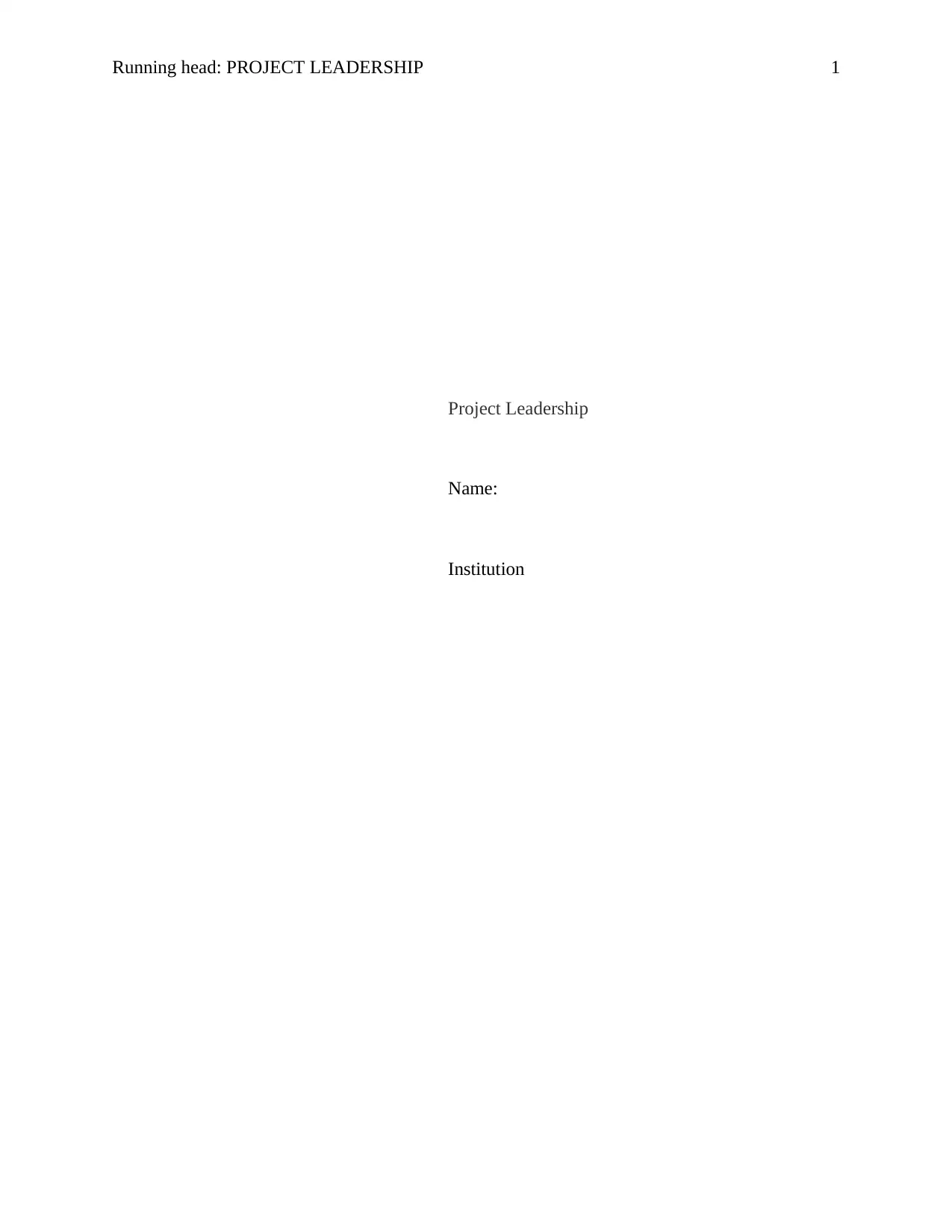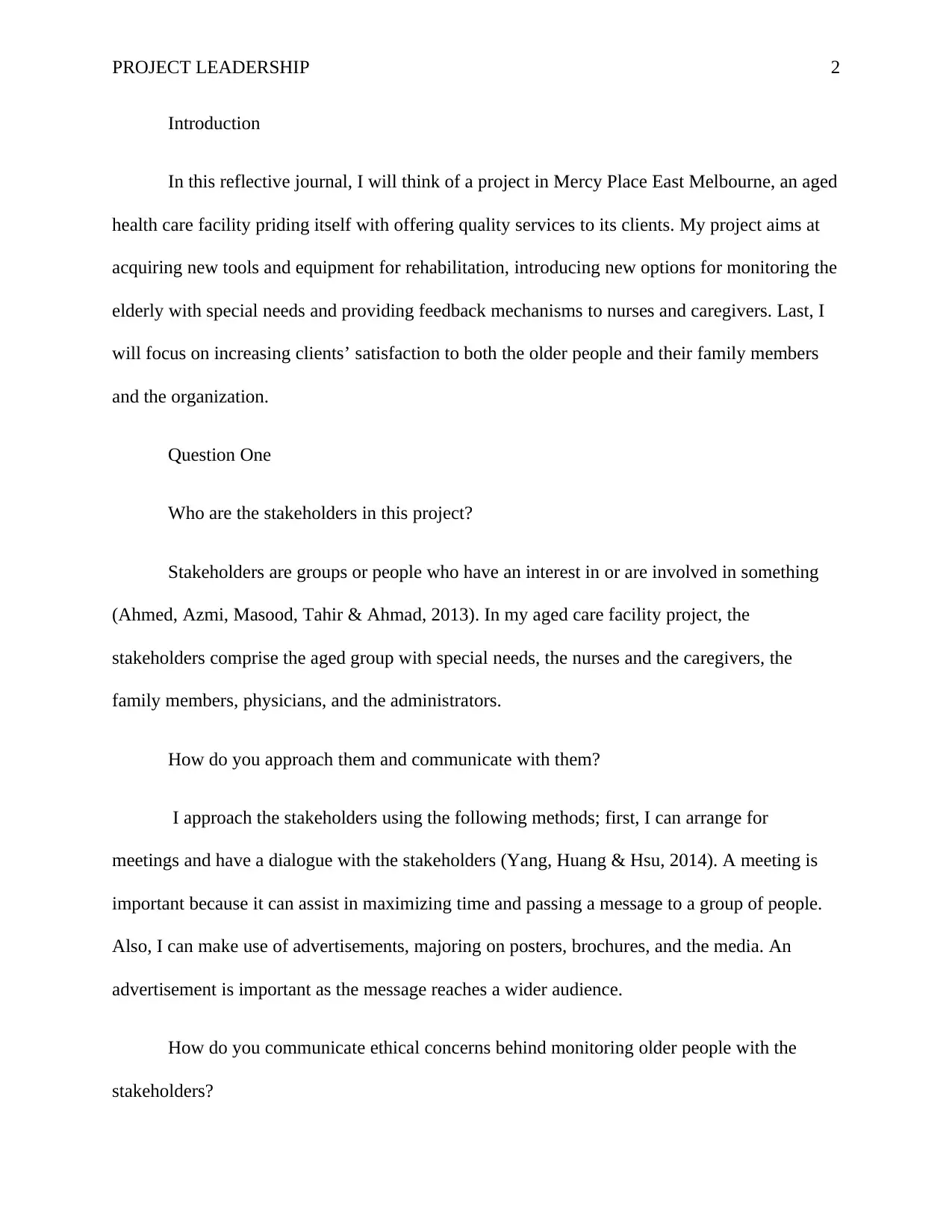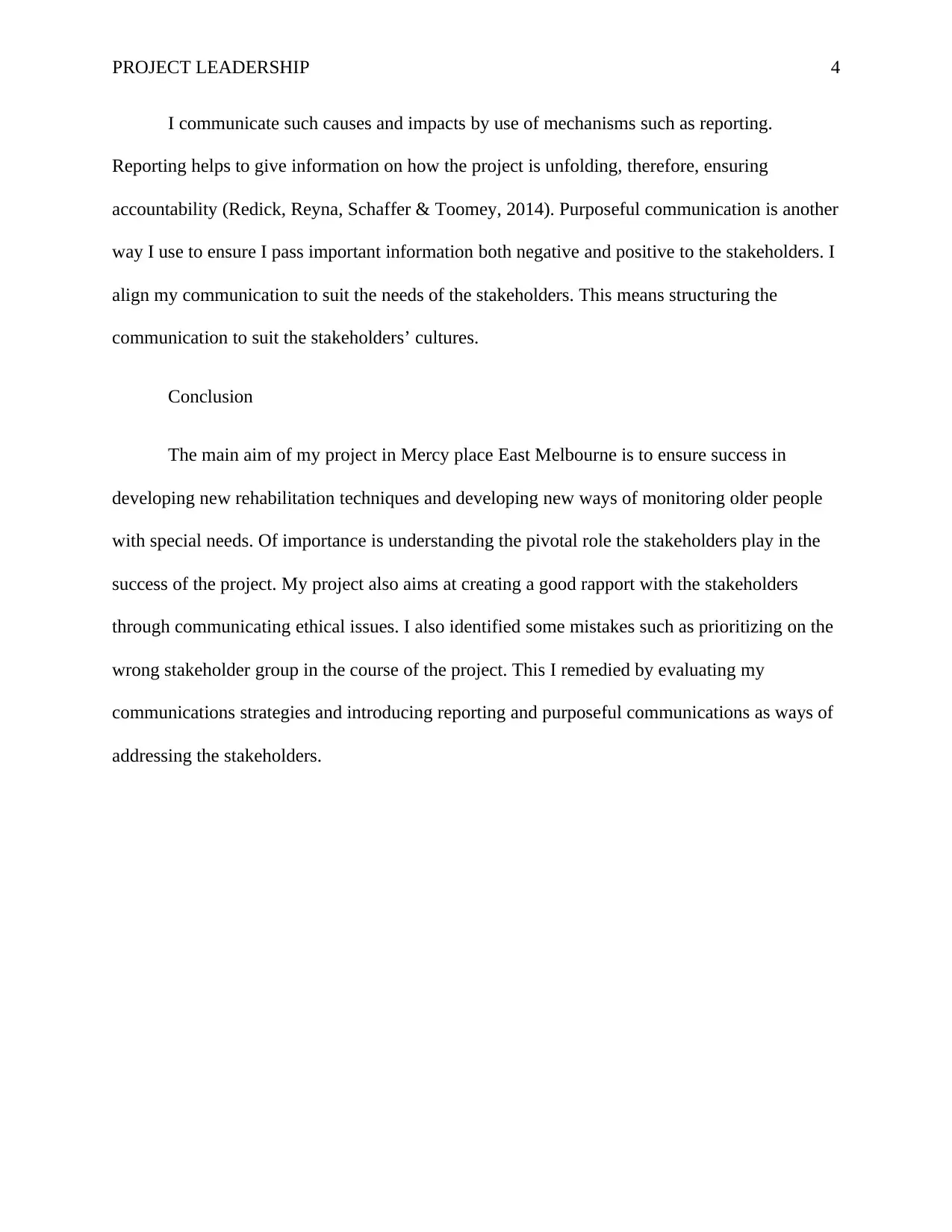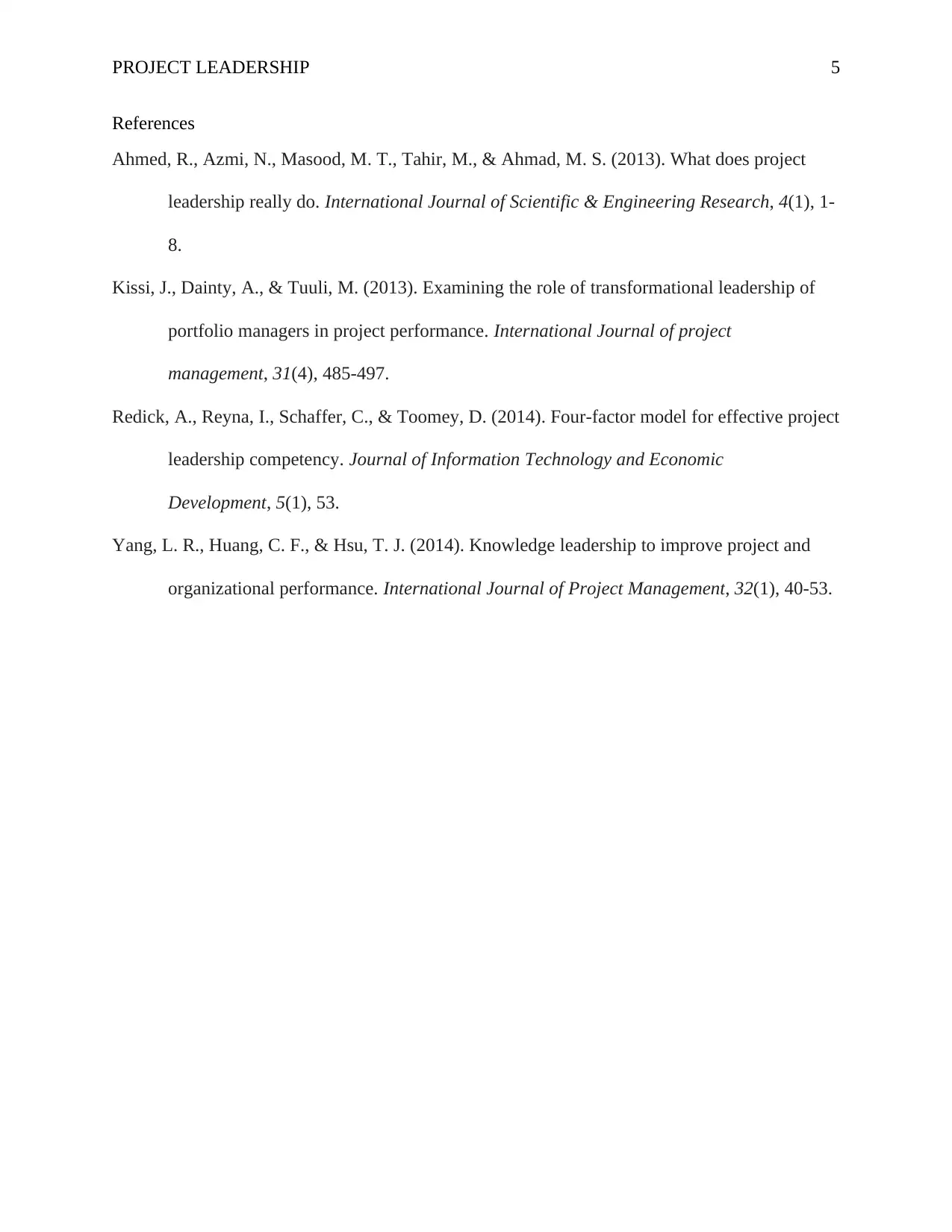MGT5PLS Reflective Journal: Project Leadership in Aged Care Facility
VerifiedAdded on 2023/06/04
|5
|963
|117
Journal and Reflective Writing
AI Summary
This reflective journal analyzes a project aimed at improving an aged care facility's services. The project focuses on acquiring new rehabilitation tools, implementing technological monitoring for elderly residents, and improving communication with nurses, caregivers, and family members. The journal addresses stakeholder identification, communication strategies, and ethical concerns related to monitoring older people. It also examines instances of stakeholder dissatisfaction and the communication of these issues. The student emphasizes the importance of stakeholder engagement and ethical considerations, while also identifying the need for improved communication and reporting mechanisms to ensure project success and stakeholder satisfaction. The journal provides valuable insights into the complexities of project leadership in a healthcare environment, highlighting the importance of stakeholder management and ethical awareness.

Running head: PROJECT LEADERSHIP 1
Project Leadership
Name:
Institution
Project Leadership
Name:
Institution
Paraphrase This Document
Need a fresh take? Get an instant paraphrase of this document with our AI Paraphraser

PROJECT LEADERSHIP 2
Introduction
In this reflective journal, I will think of a project in Mercy Place East Melbourne, an aged
health care facility priding itself with offering quality services to its clients. My project aims at
acquiring new tools and equipment for rehabilitation, introducing new options for monitoring the
elderly with special needs and providing feedback mechanisms to nurses and caregivers. Last, I
will focus on increasing clients’ satisfaction to both the older people and their family members
and the organization.
Question One
Who are the stakeholders in this project?
Stakeholders are groups or people who have an interest in or are involved in something
(Ahmed, Azmi, Masood, Tahir & Ahmad, 2013). In my aged care facility project, the
stakeholders comprise the aged group with special needs, the nurses and the caregivers, the
family members, physicians, and the administrators.
How do you approach them and communicate with them?
I approach the stakeholders using the following methods; first, I can arrange for
meetings and have a dialogue with the stakeholders (Yang, Huang & Hsu, 2014). A meeting is
important because it can assist in maximizing time and passing a message to a group of people.
Also, I can make use of advertisements, majoring on posters, brochures, and the media. An
advertisement is important as the message reaches a wider audience.
How do you communicate ethical concerns behind monitoring older people with the
stakeholders?
Introduction
In this reflective journal, I will think of a project in Mercy Place East Melbourne, an aged
health care facility priding itself with offering quality services to its clients. My project aims at
acquiring new tools and equipment for rehabilitation, introducing new options for monitoring the
elderly with special needs and providing feedback mechanisms to nurses and caregivers. Last, I
will focus on increasing clients’ satisfaction to both the older people and their family members
and the organization.
Question One
Who are the stakeholders in this project?
Stakeholders are groups or people who have an interest in or are involved in something
(Ahmed, Azmi, Masood, Tahir & Ahmad, 2013). In my aged care facility project, the
stakeholders comprise the aged group with special needs, the nurses and the caregivers, the
family members, physicians, and the administrators.
How do you approach them and communicate with them?
I approach the stakeholders using the following methods; first, I can arrange for
meetings and have a dialogue with the stakeholders (Yang, Huang & Hsu, 2014). A meeting is
important because it can assist in maximizing time and passing a message to a group of people.
Also, I can make use of advertisements, majoring on posters, brochures, and the media. An
advertisement is important as the message reaches a wider audience.
How do you communicate ethical concerns behind monitoring older people with the
stakeholders?

PROJECT LEADERSHIP 3
I communicate ethical concerns by use of stories during meetings with the older people as
a way of creating ethical awareness. Stories help in reframing ethical concerns on the positive
side rather than being viewed in the negative. This is effective as stories inspire and engage
people. Therefore, it is easy to have stakeholders' attention and at the same time raise any
concerns that I have. Another critical way of passing the information is through social media.
Humans are highly social beings and through the advancement of modern technologies, social
networking tools are easily accessible especially among the millennials. For example,
stakeholders such as nurses and physicians can be addressed through apps such as Facebook and
Twitter. Social media has shaped the direction of communication to a multi-directional one. This
means that apart from engaging only on information concerning their work environment, the
employees can also raise ethical concerns on their daily lives.
Question two
Provide some examples that may have caused this dissatisfaction
Some of the examples that might have led to my stakeholders’ dissatisfaction included
not sharing all the information concerning the project. I failed to update them on time concerning
problems that had arisen during the implementation process of the project (Kissi, Dainty &
Tuuli, 2013). I also failed to recognize that the project’s success or failure affected them directly.
This resulted to making key decisions without consulting the stakeholders, thus violating their
trust. Another mistake was prioritizing on the wrong stakeholder group. This resulted in some of
the stakeholder feeling de-valued and unappreciated.
How do you communicate these causes and their impacts with a different type of
stakeholders?
I communicate ethical concerns by use of stories during meetings with the older people as
a way of creating ethical awareness. Stories help in reframing ethical concerns on the positive
side rather than being viewed in the negative. This is effective as stories inspire and engage
people. Therefore, it is easy to have stakeholders' attention and at the same time raise any
concerns that I have. Another critical way of passing the information is through social media.
Humans are highly social beings and through the advancement of modern technologies, social
networking tools are easily accessible especially among the millennials. For example,
stakeholders such as nurses and physicians can be addressed through apps such as Facebook and
Twitter. Social media has shaped the direction of communication to a multi-directional one. This
means that apart from engaging only on information concerning their work environment, the
employees can also raise ethical concerns on their daily lives.
Question two
Provide some examples that may have caused this dissatisfaction
Some of the examples that might have led to my stakeholders’ dissatisfaction included
not sharing all the information concerning the project. I failed to update them on time concerning
problems that had arisen during the implementation process of the project (Kissi, Dainty &
Tuuli, 2013). I also failed to recognize that the project’s success or failure affected them directly.
This resulted to making key decisions without consulting the stakeholders, thus violating their
trust. Another mistake was prioritizing on the wrong stakeholder group. This resulted in some of
the stakeholder feeling de-valued and unappreciated.
How do you communicate these causes and their impacts with a different type of
stakeholders?
⊘ This is a preview!⊘
Do you want full access?
Subscribe today to unlock all pages.

Trusted by 1+ million students worldwide

PROJECT LEADERSHIP 4
I communicate such causes and impacts by use of mechanisms such as reporting.
Reporting helps to give information on how the project is unfolding, therefore, ensuring
accountability (Redick, Reyna, Schaffer & Toomey, 2014). Purposeful communication is another
way I use to ensure I pass important information both negative and positive to the stakeholders. I
align my communication to suit the needs of the stakeholders. This means structuring the
communication to suit the stakeholders’ cultures.
Conclusion
The main aim of my project in Mercy place East Melbourne is to ensure success in
developing new rehabilitation techniques and developing new ways of monitoring older people
with special needs. Of importance is understanding the pivotal role the stakeholders play in the
success of the project. My project also aims at creating a good rapport with the stakeholders
through communicating ethical issues. I also identified some mistakes such as prioritizing on the
wrong stakeholder group in the course of the project. This I remedied by evaluating my
communications strategies and introducing reporting and purposeful communications as ways of
addressing the stakeholders.
I communicate such causes and impacts by use of mechanisms such as reporting.
Reporting helps to give information on how the project is unfolding, therefore, ensuring
accountability (Redick, Reyna, Schaffer & Toomey, 2014). Purposeful communication is another
way I use to ensure I pass important information both negative and positive to the stakeholders. I
align my communication to suit the needs of the stakeholders. This means structuring the
communication to suit the stakeholders’ cultures.
Conclusion
The main aim of my project in Mercy place East Melbourne is to ensure success in
developing new rehabilitation techniques and developing new ways of monitoring older people
with special needs. Of importance is understanding the pivotal role the stakeholders play in the
success of the project. My project also aims at creating a good rapport with the stakeholders
through communicating ethical issues. I also identified some mistakes such as prioritizing on the
wrong stakeholder group in the course of the project. This I remedied by evaluating my
communications strategies and introducing reporting and purposeful communications as ways of
addressing the stakeholders.
Paraphrase This Document
Need a fresh take? Get an instant paraphrase of this document with our AI Paraphraser

PROJECT LEADERSHIP 5
References
Ahmed, R., Azmi, N., Masood, M. T., Tahir, M., & Ahmad, M. S. (2013). What does project
leadership really do. International Journal of Scientific & Engineering Research, 4(1), 1-
8.
Kissi, J., Dainty, A., & Tuuli, M. (2013). Examining the role of transformational leadership of
portfolio managers in project performance. International Journal of project
management, 31(4), 485-497.
Redick, A., Reyna, I., Schaffer, C., & Toomey, D. (2014). Four-factor model for effective project
leadership competency. Journal of Information Technology and Economic
Development, 5(1), 53.
Yang, L. R., Huang, C. F., & Hsu, T. J. (2014). Knowledge leadership to improve project and
organizational performance. International Journal of Project Management, 32(1), 40-53.
References
Ahmed, R., Azmi, N., Masood, M. T., Tahir, M., & Ahmad, M. S. (2013). What does project
leadership really do. International Journal of Scientific & Engineering Research, 4(1), 1-
8.
Kissi, J., Dainty, A., & Tuuli, M. (2013). Examining the role of transformational leadership of
portfolio managers in project performance. International Journal of project
management, 31(4), 485-497.
Redick, A., Reyna, I., Schaffer, C., & Toomey, D. (2014). Four-factor model for effective project
leadership competency. Journal of Information Technology and Economic
Development, 5(1), 53.
Yang, L. R., Huang, C. F., & Hsu, T. J. (2014). Knowledge leadership to improve project and
organizational performance. International Journal of Project Management, 32(1), 40-53.
1 out of 5
Related Documents
Your All-in-One AI-Powered Toolkit for Academic Success.
+13062052269
info@desklib.com
Available 24*7 on WhatsApp / Email
![[object Object]](/_next/static/media/star-bottom.7253800d.svg)
Unlock your academic potential
Copyright © 2020–2025 A2Z Services. All Rights Reserved. Developed and managed by ZUCOL.





